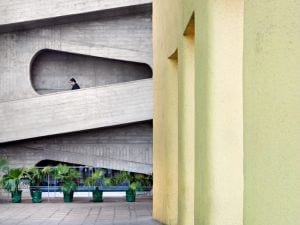Aesthetica explores 10 key art movements. Discover pioneering names and groundbreaking artworks from the 20th century.
Light and Space
The Light and Space movement originated with a group of artists based in and around Los Angeles in the 1960s. They explored how geometric shapes and illumination could transform the environment – playing with audiences’ perceptions. Key names associated with this period are James Turrell, Doug Wheeler, Robert Irwin, Larry Bell, Mary Corse, John McCracken and Helen Pashgian. The types of works range from immersive room-sized environments to smaller scale sculptures on plinths – often made using translucent materials that refract light.
Surrealism
The word ‘surrealist’ (suggesting ‘beyond reality’) was first used by the French avant-garde poet Guillaume Apollinaire in a play written in 1903. In 1924, André Breton defined it as “pure psychic automatism, by which one proposes to express, either verbally, in writing, or by any other manner, the real functioning of thought.” These artists often depicted dream worlds or hidden psychological tensions, and continue to influence contemporary practice. Famous names include Max Ernst, Salvador Dalí, René Magritte, Méret Oppenheim, Man Ray and Leonora Carrington.
Installation Art
Today, installations are widely exhibited – with works such as Yayoi Kusama’s Infinity Mirror Rooms drawing large crowds. The genre emerged in the late 1950s out of ‘environments’ – a term used by artist Allan Kaprow in 1958. It described his large-scale pieces which transformed interior spaces, and from 1960 onwards installations gained traction. They filled rooms, gallery corners and doorways. This type of art has a distinct focus on how the viewer experiences the work – often blurring the boundaries between object and audience. They can be site-specific or time-bound.
Minimalism
“What you see is what you see.” These words by painter Frank Stella (b. 1936) sum up Minimalism. It moves beyond representation: simply existing as an object in space. The movement began in the 1950s with Stella’s Black Paintings, which moved away from the expressionist art of previous generations. Key proponents include Carl Andre, Dan Flavin, Donald Judd, Sol LeWitt, Agnes Martin and Robert Morris, whose mirrored cubes are featured above. Geometric shapes are often seen within minimalism, revealing very little about the artist – they are impersonal, anonymous forms.
Conceptual Art
Ideas take centre stage in conceptual art. The term was first used to describe a movement by Sol LeWitt (1928-2007) in 1967, who said: “In conceptual art the idea or concept is the most important aspect of the work. When an artist uses a conceptual form of art, it means that all of the planning and decisions are made beforehand and the execution is a perfunctory affair.” This resulted in works which take on a range of appearances – from performances to installations to text-based prints. Appearances were not important, but meaning was paramount.
Land Art
Artworks made in or from the landscape were part of the wider conceptual movement in the 1960s and 1970s. They continue to influence artists today, who are responding to our changing climate and experimenting with human perception. Key examples include Robert Smithson’s (1938-1973) iconic Spiral Jetty, which is located on the north-eastern shore of the Great Salt Lake, Utah. The coil is made from over 6,000 tons of black basalt rocks and earth – stretching to 1,500 feet long and 15 feet wide. Nancy Holt, Richard Long, Walter de Maria and Michael Heizer are names to know.
Video Art
Nam June Paik (1932-2006) is often known as “the father of video art,” recognised for incorporating technologies such as TV into installations. He brought mass media into the gallery space in the 1960s. Fast forward to the 21st century, and artists are continuing to push the boundaries of video. Featured above is a still from Bill Viola’s (b. 1951) Five Angels for the Millennium, 2001. A male figure rises and plunges into a pool of water, fully clothed. Shown across fives screens, it is part of a wider oeuvre ruminating on life, death and rebirth.
Performance Art
The history of performance dates back to Dada cabarets of the 1910s. Actions carried out by artists are the focus – whether recorded or live. Marina Abramović is one of the most recognised names in the field, continually testing the limits of her own physical and mental endurance in her work. She has said: “I test the limits of myself in order to transform myself, but I also take energy from the audience and transform it… a powerful performance will transform everyone in the room.”
Public Art
This term refers to art that is freely available in the public realm. It could be a traditional monument, statue or sculpture – but may also extend to performances and street art. Featured above is Anish Kapoor’s (b. 1954) Cloud Gate, a mirrored form that reflects the skyline of Chicago. The stainless steel sculpture has a flawless surface, and is a popular attraction. Public art can also be used for political purposes, or protest – conveying a social message to surrounding communities.
Bauhaus
The Bauhaus only existed for 14 years, yet it left an enduring legacy. Established by Walter Gropius in Weimar, Germany, in 1919, the school revolutionised artistic thinking worldwide. As a community of creatives, it was a space for experimenting with the applied arts, design, architecture and educational methods. Teachers included Wassily Kandinsky, Paul Klee, László Moholy-Nagy and Josef Albers, advocating a “form follows function” approach to design.
Discover more art terms with Tate.
Aesthetica is a destination for art and culture. Keep up to date with some of the most important artists at work today. Subscribe and save 65% on newsstand prices.




